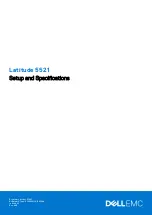
www.selectronix.us
Selectronix, Inc.
(425) 788-2979
SLC4075 TouchScreen Gateway Installation & Operating Manual
___________________________________________________________________________________________________
14
PID Tuning Procedure
The PID control loop is designed to accommodate a very large range of control installations, and as such may require
adjustments from the default values to provide the desired control characteristics. The following steps provide a guideline
for establishing the correct settings.
1.
Start with the actual temperature or pressure well below the high limit so that the recovery rate-of-change, and
overshoot may be monitored. Ideally, the initial starting point is a cold plant.
2.
Enter a set point which is above the actual temperature or pressure by the worst-case differential, but still well below
the high limit so that overshoot may be monitored.
3.
Start with a typical P = 1000, I = 5, and D=0,
4.
Enable the system and observe the following responses:
a.
the initial rate of change of the step command output, which drives the step controller or flame controller.
b.
the initial rate of change of the actual temperature or pressure.
c.
the rate of change of the step command output as the actual temperature approaches the setpoint.
d.
the amount and duration of temperature or pressure overshoot.
5.
With an SLC4075 firmware version of 2.17+ and an SLC4060 firmware version of 1.70+, the derivative calculation
has improved sensitivity for a slowly changing process variable, such as a steam plant, where the pressure may change
1%-5% in a minute.
a.
Enter a D =100 and repeat the response tests, observing the effect when the process variable approaches or
exceeds the set point.
b.
Adjust the D value as applicable.
6.
An alternative to using a D value for systems with high thermal inertia, is to increase the On Delay timing on the
SLC4000. The On Delay may be adjusted from 1 to 8 minutes. SW2-2 through SW2-4 set the integral minutes from 0
to 7 minutes. RV1 sets the On Delay seconds, which is added to the On Delay minutes.
7.
If the output response is too slow, adjust the P value higher or vice versa if the response cause unacceptable overshoot
or results in oscillating instability. The approximate output contribution by the P value is calculated in the example
below:
a.
As the actual temperature approaches the setpoint, the P contribution decreases to 0, and any step command output
is due to the accumulated integral.
b.
If an unacceptable amount of overshoot occurs, then decrease the P value and set the I value to 0.
c.
If the recovery rate with the level of P, An alternative to decreasing the P, enter a D value of 100 and observe the
effect on the rate of change of the process variable. For systems with a high thermal inertia, such as a steam plant,
d.
Retest until the P value results in little or no overshoot
e.
Adjust the I value by observing the amount of droop below the setpoint and the desired recovery time. If the
actual temperature does not recover within the desired time, slowly increase the I until the recovery time to
setpoint is acceptable.
f.
Repeat adjustments until the desired response is achieved.
g.
Set the desired setpoint and retest to verify the response.
8.
TSGW Version 2.15+ and on includes a Trend graph Page 22 that shows:
a.
Step Command %
b.
RTD1
c.
GPA1 in Engr units
The graph is continually updated on a 60 second time period, which may be helpful in tuning the PID. The logged data
is not saved.














































